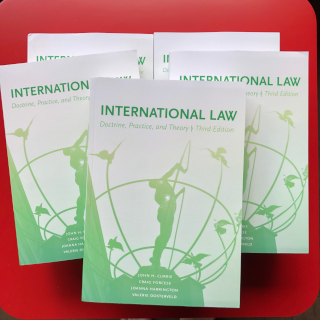Prof. Joanna Harrington co-authors new edition of textbook used across Canada for the study of international law
Carmen Rojas - 15 November 2022

Professor Joanna Harrington, together with Professors John H. Currie and Craig Forcese of the University of Ottawa, and Professor Valerie Oosterveld from Western University, recently co-authored a third edition of their influential volume, International Law: Doctrine, Practice, and Theory.
Long used by law students across Canada as a comprehensive introductory textbook for the study of international law, the book has also become a sought-out reference collection for practitioners and judges. As Harrington explains, “the original aim was to write a combination of textbook and casebook that was accessible for law students, but we find it being used by lawyers in court and by judges.”
Indeed, the work has now been cited twice by the Supreme Court of Canada, in Kazemi Estate v Islamic Republic of Iran (2014) and Nevsun Resources Ltd v Araya (2020).
“International law is a large and constantly evolving system of law, within which there are various fields, from international economic law and trade law to international security, human rights law and international criminal law – all of which also have some degree of impact on the Canadian legal ecosystem,” says Harrington. “International law is a prominent source for law reform and policy development, and it influences the interpretation and application of Canadian law.”
As for the need for a new edition, Harrington explains, “There are well-established rules within the international legal order, and Canada is known as a prominent international rule of law advocate, but obvious realities, including Russia’s aggression against Ukraine and the increase in dissatisfaction with the abilities of international institutions to effectively address such crises, prompted a need to revise and reassess how best to present the utility of international law. A worldwide pandemic, the communications revolution, technological change, and increased activities in outer space and the oceans, also led to a need to revise the book to keep it up-to-date for practice.”
As Harrington points out, the foundation upon which the authors’ work is built has not shifted. “Some important international law rules remain constant and long-established,” she says. “But we aim to bring to life the practice of international law, by ensuring readers have access to the primary materials that are essential to understanding modern international law, alongside coverage of historical and doctrinal developments.”
In keeping with past editions, the book also makes a point to provide readers with contemporary examples to illustrate international law’s continued relevance to real-world situations.